I’d Rather Be Lucky Than Good…(Mike Kelly)
Back in the late 1990’s, at Clay Coyote Pottery, we were lucky enough to have been introduced to the incredible person and author, Paula Wolfert. We got a call one day from a woman who had been referred to us by a New York Times Food editor, because she needed a large colander for steaming couscous (the traditional way) for a demonstration she was giving to chefs in San Francisco. We happened to have one and shipped it off. She introduced herself as Paula Wolfert. Betsy came in and told me the story and then went back and Googled “Paula Wolfert” and just about fell over. Paula is the most well-known and respected author of Moroccan and Mediterranean cookbooks, maybe in the world. She is known for doing the hard research to uncover authentic recipes and methods.
From Moroccan Couscous to France
Well, apparently the colander worked because the next call we got from Paula was wondering if we had a crock for making homemade vinegar. Well I had literally just thrown some large cookie jars that day, and by re-working them a little, turned them into Paula’s needed vinegar jar. She was working on an article for the New York Times.
Then to Southwest France
THEN she calls saying she needed a copy of a French cassole for making cassoulet for the new edition of her famous book, “Cooking of Southwest France”. Well, needless to say, we got on the learning curve for cassoulet. It is a big bowl, 14-15” across the top, 8-9” high, inverted v shaped with handles. 10 lbs. of clay to start with. I’d never regularly thrown that big, so it was time to learn. Ms. Wolfert always liked to have some local (US) source for any type of pot she recommended.
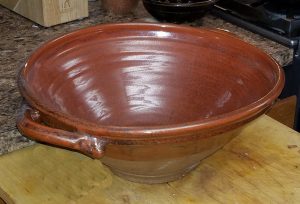 Cassole, made for Paula Wolfert’s “Cooking of SW France”. Goes in oven for finishing.
Cassole, made for Paula Wolfert’s “Cooking of SW France”. Goes in oven for finishing.Paula Turns Up The Heat
Then came flameware…she wanted a traditional low fire flameproof clay pot as are made in many older cultures and by the Native Americans in the US.
So off I went researching clays in the US that such pots could be made from. Turns out the best flame safe pots are made with a certain kind of clay, formed with mica to be flameproof. It’s called micaceous clay. Almost all known deposits in America were in the US. Southwest, most on sacred grounds and nobody mined them except Native Americans. The other large deposits had been in Florida and had been pushed into the ocean as landfill. The pots also are hand-built because the clay isn’t plastic enough for wheel throwing. You can also find lots of other earthenware flame resistant pots both from native clays and formulated blended low-fire clays.
Paula Doesn’t Give Up Easily
So when I reported back to Paula that I couldn’t do what she wanted, she introduced me to a potter named Bill Sax who had been making flameware pots for some 20 years in Massachusetts but was retiring. She had gotten him to agree to give us his flameware clay formula. There was another potter who made flameware in Fitzwilliam, NH, named Terry Silverman. Actually we had seen him at the Rosen Wholesale show for several years.
So we took Bill’s recipe and tried to hand-mix a small batch of clay. I made a few test pieces like skillets and saucepans. Gave one to one of the women who worked in the Clay Coyote Gallery, Ann Lewandowski. She called me that evening and asked if I’d come over and help her scrape her family’s dinner off the ceiling. Yes, the pot literally exploded.
Figuring Out Why So Many Had Failed With Flameware
More research, testing, trial and error. I found out that this flameware recipe had originally been patented by a William Crandall, a professor at Albert University in New York. His recipe had been spread around the East Coast by a well known potter Karen Karnes at workshops. And most who tried it had the same failures we had. If not explosions, at least failure by cracking either immediately or after up to several heating and cooling cycles.

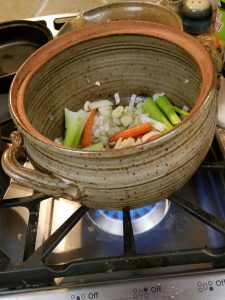
But because Bill had made it work, and Terry was still producing pots, I knew it COULD work. So we set off to find out the secrets. But first we had to invent glazes and find someone to make the clay. Since, so few people worked in flameware, there wasn’t the usual slew of glaze recipes being traded around. Because of the materials that made up this clay, normal glazes would dramatically change color, and, because the final fired pot didn’t expand and contract, neither could the glaze.
If at First You Don’t Succeed…..
We finally got that figured out, sent the clay off for testing by Ron Roy in Canada. Meantime we had gotten our clay supplier to agree to mix the clay. Then we began testing. First on ourselves. Then our employees and some loyal customers. Initially all was quiet. A few cracks, especially after many uses. So I went to work on that issue using what I had learned about the structure of clay and what I could do to stop the cracking. Finally after 2 years we had it.
So we went out hunting for pots that were for recipes for which the flameware capability made sense. If it was a dish that just went in the oven, regular stoneware was fine. Well, we found there were many. Skillets, cazuelas, dutch ovens. And then one day I was grilling some veggies in a metal grill pan Betsy had bought me. But it was frustrating. The veggies went from cooking to burned almost instantly. I wondered….
A Star is Grilled
I had just made some skillets that day and they were still drying. What if I drilled some holes in one, finished it and tried it as a grill pan? Lo and behold. Just needed to change the handle so it fit in the grill and the ceramic flameware grill basket, or pan, was born. And because of the nature of clay as an insulator it slowed down the heat transfer and no more burned veggies. Turned out it was also swell for everything from shrimp and fish, and more. Grilled potatoes are one of the best dishes you’ll ever eat.
There are lots of advantages in using your Flameware Grill Basket for grillling various meats.
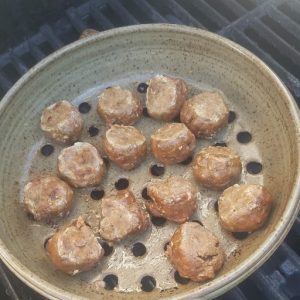 G
G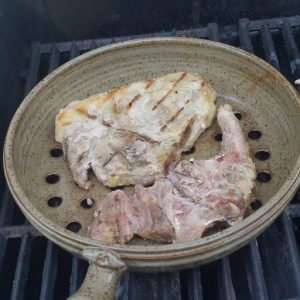
Grilled fish is great because you get the grill flavor without the fish sticking to the grill and falling apart. Steaks and chops even, because the grill basket helps prevent flare-ups.
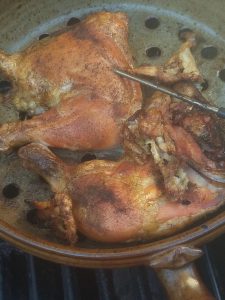
And best of all the meats, chicken grilled in a grill basket doesn’t flare up as much.
So One More Challenge
But Paula wasn’t done with us yet. She wanted a tagine for her new book “Mediterranean Clay Pot Cooking”. But she wanted it in the traditional Clay Coyote glaze colors. Now we had a problem. As clay dries and is fired, it shrinks. And flameware shrinks at a dramatically different rate than the stoneware for which all our glazes were formulated.
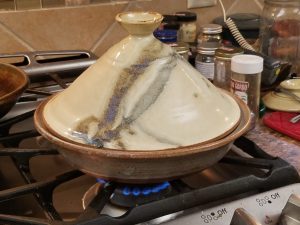
And a shape like a tagine lid doesn’t consistently shrink the same amount around the opening. So we ended up with a wide variety of stoneware lids and flameware bottoms. But, I slowly learned how make most of them fit.
So I asked Paula, the question why the lid was shaped like that…it’s a fairly hard shape to throw and, potters being lazy, wouldn’t do it for fun. She researched more and found out the true way to make tagine is put meat or a large veggie in the center and then stack vegetables done in a long julienne around like a campfire.
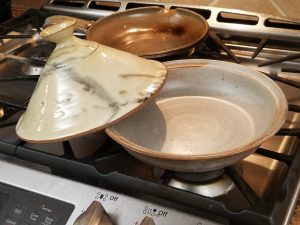
Then, as the dish cooks,especially if there’s meat in the center, it gets basted from the top. Toward the end of cooking,as the liquid reduces, the veggies stacked around get roasted and sweetened as the sugars in them are caramelized, an effect you won’t get in a high liquid “stew” type environment.
Make a Pot, Make A Friend
I also have to say that helping Paula on the clay technology part of the book was one of my most rewarding experiences as a potter. And I got a friend from it. And learned more about pottery than I could have ever imagined.

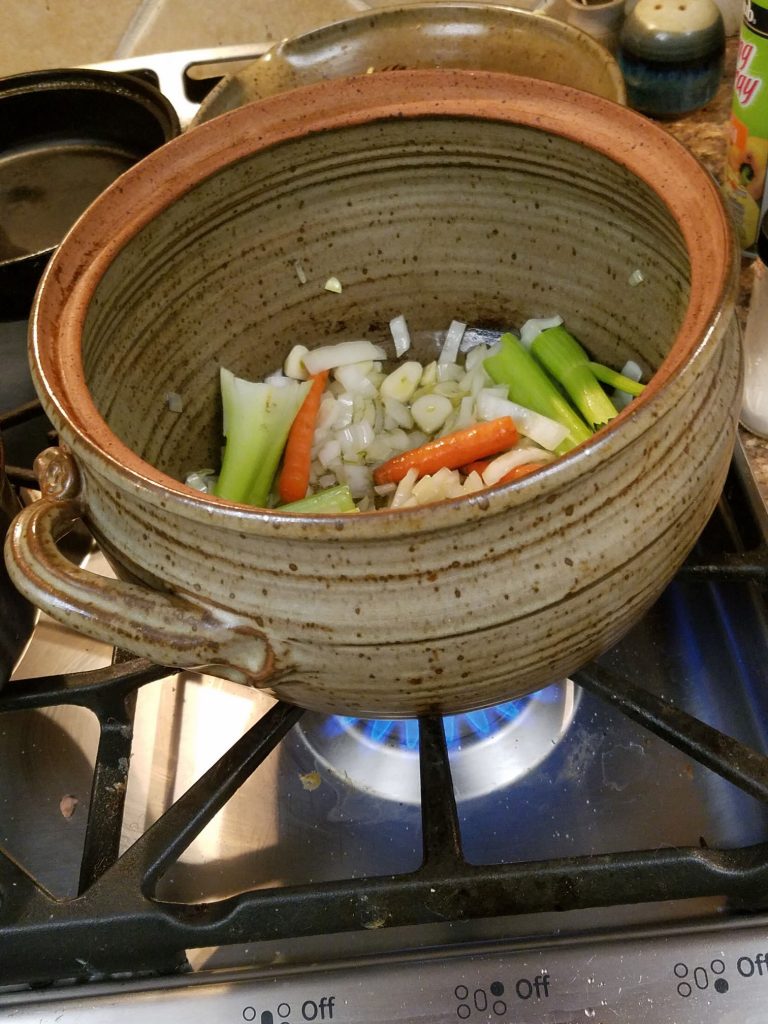
Beautiful pots! I’m approaching to flameware pots too, but i’m a little bit scared about the glazing! Do you use special receipts to avoid crazing?
I can and have shared the recipes with people. I developed it from the work by Bill Crandall, the professor who invented the Flameware clay recipe back in the 70’s. This is a specially formulated glaze just for the Flameware. It is completely non-toxic and food-safe. It is fired to a very high temperature and is completely bonded to the clay body. I do get 2 “colors” from this one glaze, thinner, it’s a speckled reddish-brown, and thicker it goes toward a gray white. Neither should craze.